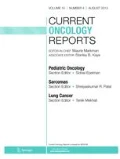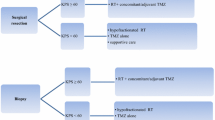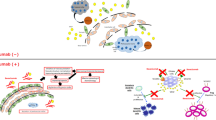Abstract
Local control with surgery, radiation, and temozolomide chemotherapy remain the pillars of treatment for high-grade gliomas. Novel therapeutic strategies, including a variety of antiangiogenic agents, are under investigation. One of these agents, bevacizumab, was recently given accelerated approval by the US Food and Drug Administration as a single agent for recurrent glioblastoma. Recent trial results are generating important clinical questions regarding which patients to treat and when, and how best to monitor response. Encouraging results of recent studies are driving willingness to undertake aggressive treatment and to improve outcomes in this population. In this era, better understanding of biology, molecular aspects of cancer, and clinical trial methodology are crucial for clinicians. This review focuses on recent advances in the treatment malignant gliomas, especially antiangiogenic therapy.

Similar content being viewed by others
References
Papers of particular interest, published recently, have been highlighted as: • Of importance •• Of major importance
Central Brain Tumor Registry of the United States (CBTRUS): 2008 statistical report: primary brain tumors in the United States. Available at http://www.cbtrus.org/reports/reports.html. Accessed November 2009.
Stupp R, Mason WP, van den Bent MJ, et al.: Radiotherapy plus concomitant and adjuvant temozolomide for glioblastoma. N Engl J Med 2005, 352:987–996.
•• Stupp R, Hegi ME, Mason WP, et al.: Effects of radiotherapy with concomitant and adjuvant temozolomide versus radiotherapy alone on survival in glioblastoma in a randomised phase III study: 5-year analysis of the EORTC-NCIC trial. Lancet Oncol 2009, 10:459–466. This is the update of the original EORTC/NCIC study [2] that defined the standard of care for TMZ/RT with 5-year survival data.
Khasraw M, Bell D, Wheeler H: Long-term use of temozolomide: could you use temozolomide safely for life in gliomas? J Clin Neurosci 2009, 16:854–855.
Abrey LE, Louis DN, Paleologos N, et al.: Survey of treatment recommendations for anaplastic oligodendroglioma. Neuro Oncol 2007, 9:314–318.
Wick W, Hartmann C, Engel C, et al.: NOA-04 randomized phase III trial of sequential radiochemotherapy of anaplastic glioma with procarbazine, lomustine, and vincristine or temozolomide. J Clin Oncol 2009 Nov 9 (Epub ahead of print).
• Deangelis LM: Anaplastic gliomas. J Clin Oncol 2009 Nov 9 (Epub ahead of print). This editorial discusses two studies in anaplastic glioma, including Wick et al. [6].
Preusser M, Janzer RC, Felsberg J, et al.: Anti-O6-Methylguanine-Methyltransferase (MGMT) immunohistochemistry in glioblastoma multiforme: observer variability and lack of association with patient survival impede its use as clinical biomarker. Brain Pathol 2008, 18:520–532.
Hegi ME, Liu L, Herman JG, et al.: Correlation of O6-methylguanine methyltransferase (MGMT) promoter methylation with clinical outcomes in glioblastoma and clinical strategies to modulate MGMT activity. J Clin Oncol 2008, 26:4189–4199.
Brandes AA, Franceschi E, Tosoni A, et al.: MGMT promoter methylation status can predict the incidence and outcome of pseudoprogression after concomitant radiochemotherapy in newly diagnosed glioblastoma patients. J Clin Oncol 2008, 26:2192–2197.
Gerstner ER, McNamara MB, Norden AD, et al.: Effect of adding temozolomide to radiation therapy on the incidence of pseudo-progression. J Neurooncol 2009, 94:97–101.
• Brandsma D, Stalpers L, Taal W, et al.: (2008). Clinical features, mechanisms, and management of pseudoprogression in malignant gliomas. Lancet Oncol 2008, 9:453–461. This is an excellent overview of pseudoprogression in GBM.
Brandes AA, Tosoni A, Amista P, et al.: How effective is BCNU in recurrent glioblastoma in the modern era? A phase II trial. Neurology 2004, 63:1281–1284.
Wick W, Platten M, Weller M: New (alternative) temozolomide regimens for the treatment of glioma. Neuro Oncol 2009, 11:69–79.
Lassman AB, Rossi MR, Raizer JJ, et al.: Molecular study of malignant gliomas treated with epidermal growth factor receptor inhibitors: tissue analysis from North American Brain Tumor Consortium Trials 01–03 and 00–01. Clin Cancer Res 2005, 11:7841–7850 (published correction appears in Clin Cancer Res 2006, 12:322).
Mellinghoff IK, Wang MY, Vivanco I, et al.: Molecular determinants of the response of glioblastomas to EGFR kinase inhibitors. N Engl J Med 2005, 353:2012–2024.
Hanahan D, Folkman J: Patterns and emerging mechanisms of the angiogenic switch during tumorigenesis. Cell 1996, 86:353–364.
Berger AC, Zalotoris A, Gugger DR, Watson JC: Mature circulating endothelial cells are increased in cancer patients receiving anti-angiogenic therapy. J Am Coll Surgeons 2003, 197:S83–S84.
Hicklin DJ, Ellis, LM: Role of the vascular endothelial growth factor pathway in tumor growth and angiogenesis. J Clin Oncol 2005, 23:1011–1027.
Stark-Vance V: Bevacizumab and CPT-11 in the treatment of relapsed malignant glioma [abstract 342]. Neuro Oncol 2005, 7:369.
Kreisl TN, Kim L, Moore K, et al.: Phase II trial of single-agent bevacizumab followed by bevacizumab plus irinotecan at tumor progression in recurrent glioblastoma. J Clin Oncol 2009, 27:740–745.
Vredenburgh JJ, Desjardins A, Herndon JE 2nd, et al.: Bevacizumab plus irinotecan in recurrent glioblastoma multiforme. J Clin Oncol 2007, 25:4722–4729.
•• Friedman HS, Prados MD, Wen PY, et al.: Bevacizumab alone and in combination with irinotecan in recurrent glioblastoma. J Clin Oncol 2009, 27:4733–4740. This is the study that led to accelerated approval by the US Food and Drug Administration of bevacizumab for recurrent GBM.
• Weller M, Yung WK: Bevacizumab: news from the fast lane? Neuro Oncol 2008, 10:647. This excellent commentary discusses the nuances of antiangiogenic therapies and the use of irinotecan in recurrent glioma.
Reardon D, Desjardins A, Vredenburgh J, et al.: Safety and efficacy of bevacizumab and metronomic, oral etoposide for recurrent glioblastoma patients in a phase II study. Neuro Oncol 2008, 10:839.
Maron R, Vredenburgh JJ, Desjardins A, et al.: Bevacizumab and daily temozolomide for recurrent glioblastoma multiforme (GBM). J Clin Oncol (Meeting Abstracts) 2008, 26:2074.
Gutin PH, Iwamoto FM, Beal K, et al.: Safety and efficacy of bevacizumab with hypofractionated stereotactic irradiation for recurrent malignant gliomas. Int J Radiat Oncol Biol Phys 2009, 75:156–163.
Gruber ML, Raza S, Gruber D, Narayana A: Bevacizumab in combination with radiotherapy plus concomitant and adjuvant temozolomide for newly diagnosed glioblastoma: update progression-free survival, overall survival, and toxicity. J Clin Oncol (Meeting Abstracts) 2009, 27:2017.
Curran WJ Jr, Scott CB, Horton J, et al.: Recursive partitioning analysis of prognostic factors in three Radiation Therapy Oncology Group malignant glioma trials. J Natl Cancer Inst 1993, 85:704–710.
Lai A, Nghiemphu P, Green R, et al.: Phase II trial of bevacizumab in combination with temozolomide and regional radiation therapy for up-front treatment of patients with newly diagnosed glioblastoma multiforme. J Clin Oncol (Meeting Abstracts) 2009, 27:2000.
Lai A, Filka E, McGibbon B, et al.: Phase II pilot study of bevacizumab in combination with temozolomide and regional radiation therapy for up-front treatment of patients with newly diagnosed glioblastoma multiforme: interim analysis of safety and tolerability. Int J Radiat Oncol Biol Phys 2008, 71:1372–1380.
Pope WB, Lai A, Nghiemphu P, et al.: MRI in patients with high-grade gliomas treated with bevacizumab and chemotherapy. Neurology 2006, 66:1258–1260.
Iwamoto FM, Abrey LE, Beal K, et al.: Patterns of relapse and prognosis after bevacizumab failure in recurrent glioblastoma. Neurology 2009, 73:1200–1206.
Chen W, Delaloye S, Silverman DH, et al.: Predicting treatment response of malignant gliomas to bevacizumab and irinotecan by imaging proliferation with [18F] fluorothymidine positron emission tomography: a pilot study. J Clin Oncol 2007, 25:4714–4721.
Pope WB, Kim HJ, Huo J, et al.: Recurrent glioblastoma multiforme: ADC histogram analysis predicts response to bevacizumab treatment. Radiology 2009, 252:182–189.
Quant EC, Norden AD, Drappatz J, et al.: Role of a second chemotherapy in recurrent malignant glioma patients who progress on bevacizumab. Neuro Oncol 2009, 11:550–555.
• Batchelor TT, Sorensen AG, di Tomaso E, et al.: AZD2171, a pan-VEGF receptor tyrosine kinase inhibitor, normalizes tumor vasculature and alleviates edema in glioblastoma patients. Cancer Cell 2007, 11:83–95. This excellent translational study demonstrates changes in imaging and biologic parameters during treatment with the oral anti-VEGFR TKI cedirinib (AZD2171).
Byzova TV, Goldman CK, Pampori N, et al.: A mechanism for modulation of cellular responses to VEGF: activation of the integrins. Mol Cell 2000, 6:851–860.
Choi S, Lee SA, Kwak TK, et al.: Cooperation between integrin alpha5 and tetraspan TM4SF5 regulates VEGF-mediated angiogenic activity. Blood 2009, 113:1845–1855.
Meredith JE Jr, Fazeli B, Schwartz MA: The extracellular matrix as a cell survival factor. Mol Biol Cell 1993, 4:953–961.
Nabors LB, Mikkelsen T, Rosenfeld SS, et al.: Phase I and correlative biology study of cilengitide in patients with recurrent malignant glioma. J Clin Oncol 2007, 25:1651–1657.
Reardon DA, Fink KL, Mikkelsen T, et al.: Randomized phase II study of cilengitide, an integrin-targeting arginine-glycine-aspartic acid peptide, in recurrent glioblastoma multiforme. J Clin Oncol 2008, 26:5610–5617.
Stupp R, Goldbrunner R, Neyns B, et al.: (2007). Phase I/IIa trial of cilengitide (EMD121974) and temozolomide with concomitant radiotherapy, followed by temozolomide and cilengitide maintenance therapy in patients (pts) with newly diagnosed glioblastoma (GBM). J Clin Oncol (Meeting Abstracts) 2007, 25:2000.
Grossman SA, Ye X, Chamberlain M, et al.: Talampanel with standard radiation and temozolomide in patients with newly diagnosed glioblastoma: a multicenter phase II trial. J Clin Oncol 2009, 27:4155–4161.
Butowski N, Chang SM, Junck L, et al.: A phase II clinical trial of poly-ICLC with radiation for adult patients with newly diagnosed supratentorial glioblastoma: a North American Brain Tumor Consortium (NABTC01-05). J Neurooncol 2009, 91:175–182.
Rosenfeld MR, Chamberlain M, Grossman SA, et al.; New Approaches to Brain Tumor Therapy: A CNS Consortium: A phase II study of chemoradiation followed by adjuvant temozolomide and poly-ICLC in patients with newly diagnosed glioblastoma: 12- and 18-month survival data (NABTT 0501). J Clin Oncol (Meeting Abstracts) 2009, 27:2002.
Wheeler CJ, Black KL, Liu G, et al.: Vaccination elicits correlated immune and clinical responses in glioblastoma multiforme patients. Cancer Res 2008, 68:5955–5964.
Heimberger AB, Archer GE, Mitchell DA, et al.: (2009). Epidermal growth factor receptor variant III (EGFRvIII) vaccine (CDX-110) in GBM. J Clin Oncol (Meeting Abstracts) 2009, 27:2021.
van den Bent MJ, Vogelbaum MA, Wen PY, et al.: End point assessment in gliomas: novel treatments limit usefulness of classical Macdonald’s criteria. J Clin Oncol 2009, 27:2905–2908.
Grossman SA, Ye X, Piantadosi S, et al.: Current survival statistics for patients with newly diagnosed glioblastoma treated with radiation and temozolomide on research studies in the United States [abstract]. J Clin Oncol 2009, 27:2003. This meeting abstract provides an interesting analysis of the survival statistics in recently presented trials for newly diagnosed glioblastoma.
Disclosure
Dr. Andrew B. Lassman has served on scientific advisory boards and/or consulted for Schering-Plough Corporation, Sigma-Tau Pharmaceuticals, Bristol-Myers Squibb, ImClone Systems, Genentech, Eisai, Cephalon, and Enzon Pharmaceuticals. He also serves on the editorial board of the Journal of Neuro-Oncology and the speakers’ bureau for Schering-Plough Corporation.
No other potential conflicts of interest relevant to this article were reported.
Author information
Authors and Affiliations
Corresponding author
Rights and permissions
About this article
Cite this article
Khasraw, M., Lassman, A.B. Advances in the Treatment of Malignant Gliomas. Curr Oncol Rep 12, 26–33 (2010). https://doi.org/10.1007/s11912-009-0077-4
Published:
Issue Date:
DOI: https://doi.org/10.1007/s11912-009-0077-4




